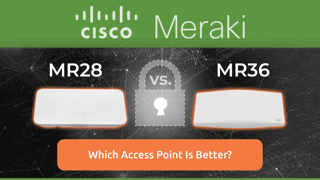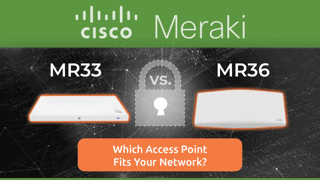Meraki MR36 vs MR44: Pick the Right Wi-Fi 6 Access Point for Your Network
Table of Contents
Selecting the right Meraki access point primarily depends on your power budget, port speed, and the number of devices you need to support simultaneously. With the MR36 vs MR44, the MR36 hits the mark for smaller offices and retail floors that rarely exceed 40 active clients, while the MR44 adds multigigabit uplink and extra 5 GHz radio chains for spaces that stay busier.
The side-by-side details below translate those technical gaps into clear, real-world outcomes so you can select the model that fits your business.
Overview Of The MR36 vs MR44 Meraki Access Point Lineup
Meraki offers a full ladder of Wi-Fi 6 hardware, but MR36 and MR44 land squarely in the “most networks need this” bracket. Think of MR36 as the streamlined option for everyday offices, while MR44 adds the muscle you’ll want once headcounts and bandwidth spikes start to climb.
Cisco Meraki’s indoor MR series stretches from the value-priced MR20 up to the flagship MR57. The MR36 is the entry Wi-Fi 6 option with a 2×2 radio set, ideal for modest device counts. Step up to MR44 and you gain a mixed 2×2 / 4×4 design, multigigabit uplink, and more headroom when rooms get crowded.
MR36 vs MR44: In-Depth Comparison Of Specifications And Features
Specs can feel like an alphabet soup, so we lined them up side by side. Scan the table below to spot the real-world differences—radio chains, uplink speed, power draw, without wading through a datasheet.
Feature | MR36 | MR44 |
Wi-Fi standard/radio chains | 2×2:2 MU-MIMO, 802.11ax | 2×2:2 (2.4 GHz) + 4×4:4 (5 GHz), 802.11ax |
Max aggregate frame rate | 1.5 Gbps | 2.7 Gbps |
Ethernet uplink | 1 × 1 GbE RJ-45 | 1 × 2.5 GbE mGig RJ-45 |
PoE class/draw | 802.3af, 15 W max | 802.3af (low-power) or 802.3at, up to 30W |
Antenna gain (peak) | 5.4 dBi @ 2.4 GHz / 6 dBi @ 5 GHz | 5.1 dBi @ 2.4 GHz / 5.9 dBi @ 5 GHz |
Concurrent radios | 4 (dual-band, security, BLE) | 4 (dual-band, security, BLE) |
Dimensions (W × D × H) | 9.84 × 4.72 × 1.42 in | 12.05 × 5.06 × 1.74 in |
Client capacity* | ~40 active users | ~60–75 active users |
Warranty | Limited lifetime | Limited lifetime |
Operating temperature | 0 °C – 40 °C | 0 °C – 40 °C |
Typical use case | Small offices, boutique retail | Classrooms, open-plan floors, event venues |
Performance And Capacity Benchmarks To Consider
Numbers on paper don’t always match what you see at the help desk. These benchmarks demonstrate how each model handles live traffic, high-density rooms, and PoE limits, allowing you to predict user experience before the first access point is deployed.
Metric | MR36 | MR44 |
Single 2×2 Wi-Fi 6 client – TCP downlink (80 MHz, near-AP) | ≈ 900 Mbps | ≈ 1.3 Gbps |
Recommended client load | 30–40 devices | 60–75 devices |
Peak user throughput with mGig uplink | Capped ≈ 940 Mbps | ≈ 1.9 Gbps |
Max channel width (5 GHz) | 80 MHz | 80 MHz |
Effect of 802.3af power | Full performance | Downshifts to 2×2 and 1 GbE |
MTBF (reliability) | 257 k hrs | 500 k hrs |
Implementation Best Practices For Maximum ROI
Great hardware still needs smart placement and power planning. Use the checklist below to ensure you’re maximizing the value of every dollar from whichever model you choose.
Survey first: Map walls, interference, and device counts before final placement.
Match the model to the density: MR36 in low-traffic areas; MR44 in areas with over 50 devices crowding the airwaves.
Use the right switch ports: Standard PoE powers MR36; MR44 needs PoE+ for its 4×4 radio and 2.5 GbE port.
Keep channels narrow & let Auto-RF run: Stick to 20 MHz on 2.4 GHz and 40–80 MHz on 5 GHz.
Use Meraki Health: Set alerts for rising airtime or retransmits before users feel the pain.
Quick Troubleshooting Checklist
When Wi-Fi stalls, speed matters. Run through this punch list; each step takes under two minutes and clears most of “the network’s slow” tickets before they snowball.
Verify PoE draw: Confirm the switch port is feeding the watts the AP expects; low power forces radios to throttle or shut off.
Check uplink speed negotiation: Ensure the Ethernet link is set to 1 GbE on an MR36 or 2.5 GbE on an MR44, not limited to 100 Mb/s.
Inspect the channel plan for overlap: Spot APs stepping on the same or adjacent channels; a quick Auto-RF re-balance usually clears the air.
Confirm firmware & driver versions: Out-of-date AP firmware or client drivers create bugs that masquerade as RF issues; rule them out first.
Scan for RF interference: Microwaves, wireless cameras, and DECT phones blast noise that cripples throughput; a spectrum scan spots the culprits.
Review Meraki Health alerts: The dashboard flags packet loss, high airtime use, and rogue APs; clear those alerts before escalating.
Need Expert Opinion In Choosing The Best Meraki Access Point For Your Business?
Still torn? A quick call with our engineers can save hours of second-guessing. We’ll map your floor plan, device mix, and growth targets, then point you to the right gear, minus the hard sell.
MR36 suits branch offices, conference rooms, and boutique retail spaces where headcounts remain modest.
MR44 excels in classrooms, call centers, and busy enterprise floors that constantly stress the network.
Contact Hummingbird Networks for expert guidance and personalized recommendations.
FAQs
Do both MR36 and MR44 support Wi-Fi 6?
Yes, both models fully support Wi-Fi 6 (802.11ax), but the MR44 offers more radio chains and higher throughput, which translates into smoother performance in busier environments.
How many devices can each Meraki access point handle?
The MR36 is recommended for about 30–40 concurrent devices, while the MR44 comfortably supports 60–75 users without performance drops.





